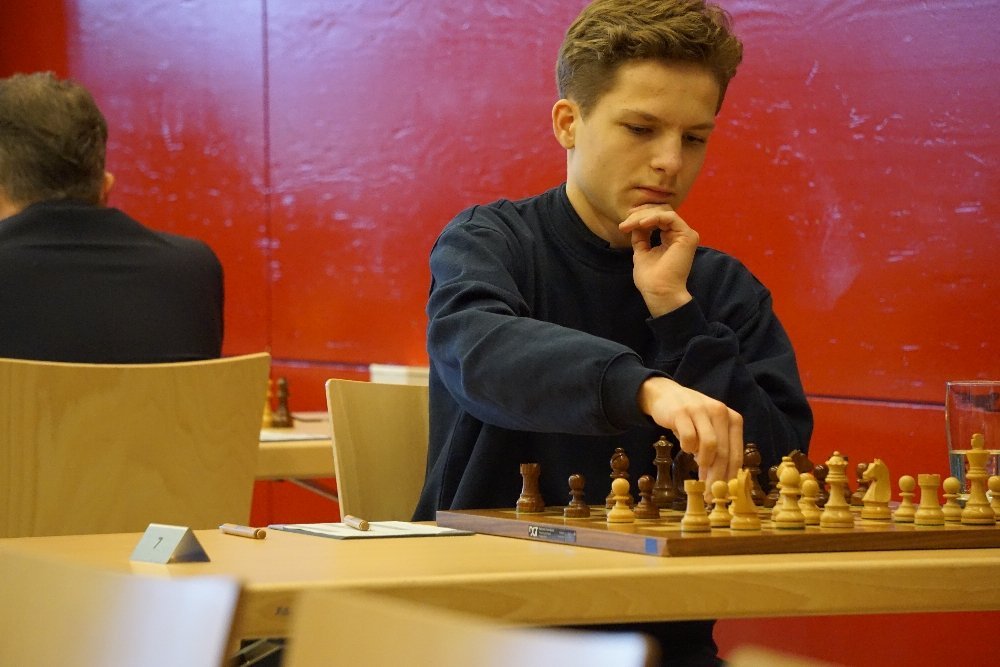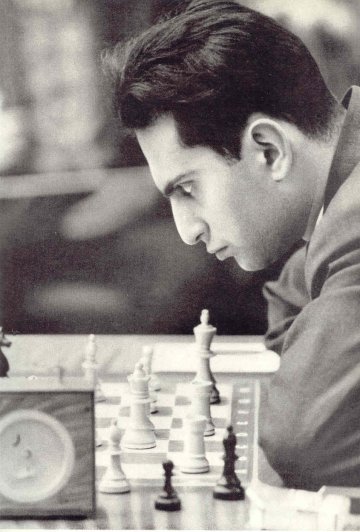.jpeg)

.jpeg)
Johannes Fischer: Hello Karsten, together with Luis Engel you recently published a course about the playing style of various players. The course is based on the book "The Human Factor in Chess" which you wrote together with Luis. When did you have the idea to look at playing styles of players and how did you cooperate?
Karsten Müller: During the pandemic, we couldn't train at the clubhouse of the Hamburger SK as usual, but we had the idea of working together as authors. I suggested a number of topics to Luis and after some back and forth we ended up with the "player types".
That made sense because as a player I am an "activist", but as a coach I am a theoretician, while Luis is a pragmatist in terms of playing type, and we complement each other well. We only lack personal experience of the playing type "reflector".

Luis Engel: "A pragmatist" | Photo: André Schulz
We had dealt with this topic in training before, and I also talked about it with Vincent Keymer during a training session a few years ago. I think this topic and its importance are generally underestimated. Lars Bo Hansen talked about it in his excellent book Foundations of Chess Strategy (Gambit 2005), but that was about it. Usually, people are satisfied with the simplified version tactician/strategist (in the model: activist+pragmatist/theorist+reflector). But I think that if you make the model a bit more complex, you gain a lot and you are able to explain the different playing types much better.
"Activists", "Theoreticians", "Reflectors", and "Pragmatists" – in this context these are new terms. Can you briefly describe what characterises each of these four playing types?
Of course! The activists among the 16 World Champions are Alekhine, Tal, Spassky, Kasparov and Anand.
The strengths of the active players: They rate initiative and attacking chances relatively high and do not care so much about material. They often have a good feeling for the initiative and for dynamics and they are often willing to accept static weaknesses for dynamic play. One of their strengths is usually the ability to calculate concrete variations based on intuition.
Their weaknesses: They sometimes make committal pawn moves that look good at the moment, but in the long run do far more harm than good. They tend to overestimate their attacking possibilities and underestimate their opponent's attacking possibilities. They are worse in defence than in attack and usually always have the possibility of winning the game in mind. In the rarer type of "hyperactive player" - to which Tal and Nezhmetdinov belong - these characteristics are even more pronounced.
The theoreticians among the World Champions are Steinitz, Botvinnik and Kramnik.
Their strengths: They know their structures extremely well. They are very familiar with all manoeuvres and plans and can rely on their intuition when applying them. They play logically and systematically. Theoreticians often play theoretical endgames particularly well and know all the relevant endgame theory by heart.

A distinctive theorist: Mikhail Botvinnik
Their weaknesses: They stick to their principles, even if these principles sometimes do not fit the position. Occasionally they lack a little sense for the limits of the applicability of this or that principle - as well as the necessary flexibility to look for other solutions in a concrete position.
The reflectors among the World Champions are: Capablanca, Smyslov, Petrosian, Karpov and Carlsen.
Their strengths: They have a very deep understanding of the game and recognise relevant patterns at first glance. They have a very fine feeling for the harmony and coordination of the pieces, and they are very good at limiting the opponent's pieces and disrupting their coordination. Typical for reflectors are active prophylaxis as well as dominance and restriction strategies. They handle strategic endgames very well because the queens no longer "disturb" and there's less chance for "chaos".

A successful "reflector": Magnus Carlsen | Photo: Lennart Ootes
Their weaknesses: They sometimes have weaknesses in calculating concrete variations, which the opponent could exploit by aiming for concrete dynamic positions in which every single move counts.

Another successful "reflector": Anatoly Karpov | Photo: V. Savostianov, Novosti Press (via D. Griffin)
The pragmatists among the World Champions are Fischer, Euwe and Lasker.
Their strengths: Pragmatists are characterised by a very concrete approach. They can often calculate very accurately and deeply and rarely make gross mistakes. They include many practically relevant factors in their decision-making process and are often good at forcing their opponents to make unpleasant practical decisions. And thanks to their abilities in calculation they are often very stubborn defenders.
Their weaknesses: Sometimes the concrete approach can be a weakness. In technical positions in which there is nothing concrete to calculate, pragmatists occasionally start to "drift". They sometimes also have difficulties in recognising long-term plans, and sometimes pragmatists (like theorists) are a bit too materialistic. Overall, however, they are relatively balanced and have hardly any serious weaknesses.
The division into player types is based on the different styles of these players. But how would you define playing style in chess?
That is, of course, a complicated issue. We follow a model of the Danish Grandmaster Lars Bo Hansen, which I think is particularly well suited. I have presented this approach in many seminars and have always been amazed at how well it works. Of course, each player has something of all four types, but one element is usually is dominant.
If I always want to get active in passive and/or bad positions because I'm too impatient to defend these positions for a long time, does that prove that I am an activist or is this just a weakness that might disappear if I work on it?
This is a typical weakness of activists, and it does not disappear by itself. One should work on it. In general, activists and certain theorists have the most pronounced weaknesses. When I look at how I played in my youth, I see this phenomenon confirmed once more.
Playing style or not - if you see a mate in five, you play it, and if a 2200 player knows the Philidor position inside out, he or she will handle this part of a rook ending just as well as Carlsen or Capablanca. Where and when do style and player type come to bear?
In the border areas. If there is only one playable move, you have to play it. That is not a question of style. But often you have the choice between several playable moves, and then knowledge about playing styles can be helpful. For me, that's exactly what makes chess so fascinating. If in each position only one move, which an algorithm could find, would be playable, chess would be far less fascinating. There are games that work like that, but they are nowhere near as popular as chess.
How pronounced are the stylistic differences between individual players? For example, if you were to see five games played by World Champions, do you think you could tell which World Champion played them?
No, I couldn't. Because the stylistic differences are not that pronounced, and of course the World Champions were all pretty universal. With a few exceptions, such as the young Mihail Tal, who was the only hyperactive player on the World Championship throne.

A pronounced activist: Mihail Tal
How did you go about assigning each player a playing style? Did you look at all the games of the respective player or did you look at a selection of games?
We made a selection and also consulted other sources.
The way people play often changes over the course of their career. Steinitz started out as an attacking player but then discovered the pleasure of defending bad positions, Kasparov played more careful and versatile after his matches against Karpov, and Kortschnoi described in his autobiography how he consciously changed his style over the course of his career. How did you deal with such phenomena when assigning player types?
We did not specifically deal with this question, but this is definitely an exciting topic which deserves further study. In general, the model invites a lot of further investigation, and we could not explore all interesting topics worth pursuing. We only point out that many activists become more pragmatic over time.
You count Bobby Fischer among the pragmatists, although in many respects he was anything but pragmatic at first glance. For example, he firmly believed in his favourite variations in the opening and until his match against Spassky in 1972 he almost always played the same openings, no matter how well prepared his opponent was or what his opponent's strengths or weaknesses were. And as with Fischer, you can perhaps classify many players as more than one type. What was the decisive factor in your classification of the individual players?
Fischer provides many instructive examples of a pragmatic approach. He has, for example, very good time management (a typical pragmatist quality) and his understanding of the game, which is shown in quotes such as "1.e4: best by test" or "to get squares you got to give squares", is also pragmatic.

Bobby Fischer
With regard to openings things have changed over time. In the past it might have been pragmatic to know your systems well and to always play them. In the past, opponents could not easily catch up with the knowledge you had accumulated over years. Today, this can be done much faster with the computer, as can be seen with the pragmatist Maxime Vachier-Lagrave and his adventures in the Najdorf Variation. "MVL" believes in the Najdorf Variation and plays it with unwavering faith, but in the Candidates Tournament 2020/2021 he was caught on the wrong foot by the pragmatist Caruana, who was prepared to the letter and won an important game with a remarkable novelty. Here, perhaps, the pragmatists of today should become more universal.
Mark Dvoretsky was a very successful coach and for him the universal player was the ideal, a player who is equally strong and good in opening, middlegame and endgame, in attack and defence, in strategy, tactics and the calculation of variations. Accordingly, his training concepts aim to eliminate weaknesses in one's playing style. But does a universal player have no style?
Ideally, yes, I guess. But you can't just decide to become a universal player. There are things and characteristics that you can't change. You either have them or you don't.
If you like, Matthew Sadler's and Natasha Regan's masterpiece Game Changer (New in Chess 2019), in which they examine the games of AlphaZero, shows that AlphaZero plays universally and almost without distinct style, because the programme can do virtually "everything".
Nevertheless, I am particularly impressed by the programme's reflector qualities, and I think that they have contributed significantly to AlphaZero's success against Stockfish – a programme with a pragmatic playing style. That's why we see AlphaZero as reflector.
Does each player have his or her own style? And how does that style change in the course of one's chess career?
I would say yes, anyone who is good enough to be able to choose between a number of moves of equal value has a style of their own. However, a player's individual style cannot always be assigned exactly to one of the four playing styles we have presented. And of course the style evolves. You can see that very well in my case. I was a somewhat one-dimensional activist in my youth and then became more pragmatic and universal over time. But I am still an activist.
Can one choose what type of player one is and would like to be, or is the type of player one is a question of disposition or chess education and early influences?
You can influence it, but you cannot choose it. However, certain qualities that activists and pragmatists possess can be learned and trained better than reflector qualities. Training alone is not enough to get Karpov's or Carlsen's feeling for the pieces.
How do I find out what type of player I am – and how can I then use this knowledge to play better or at least score better?
It helps to study your own games in the light of the model. Then you can work on your own weaknesses and try to become more universal and integrate strengths of other types of players into your own game. At the same time, you can try to exploit the weaknesses of your opponent in your games.
Thank you very much for the interview.